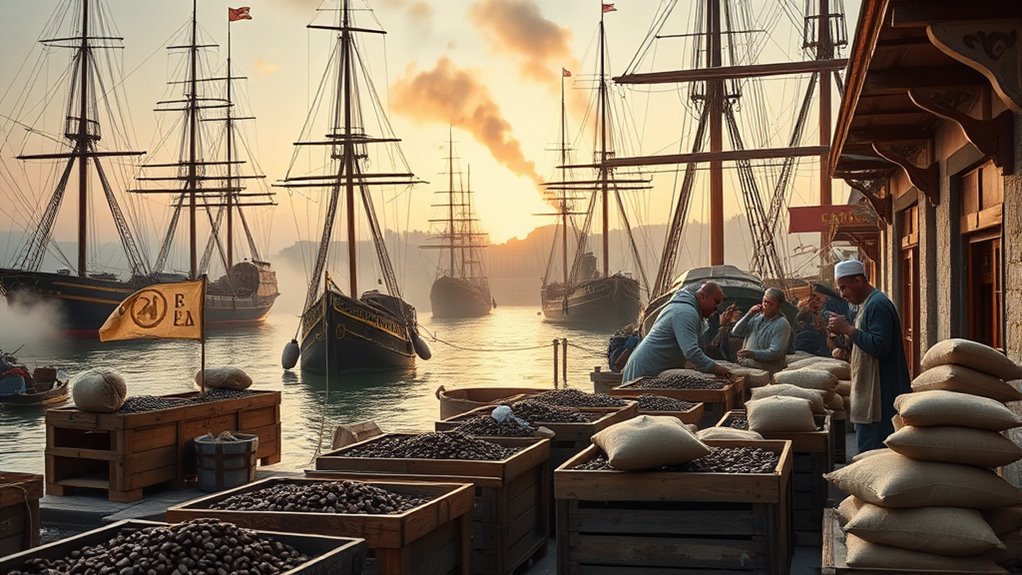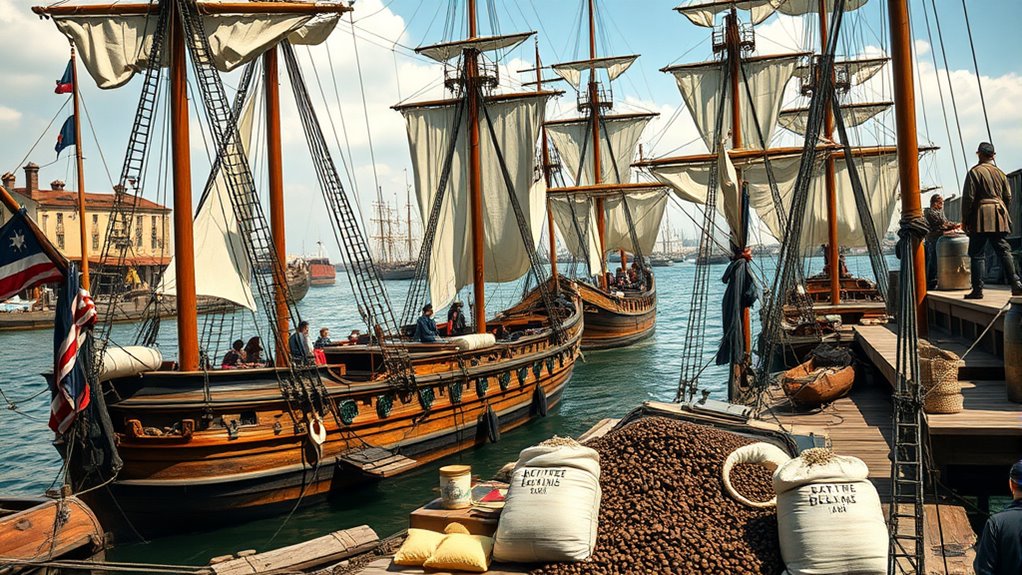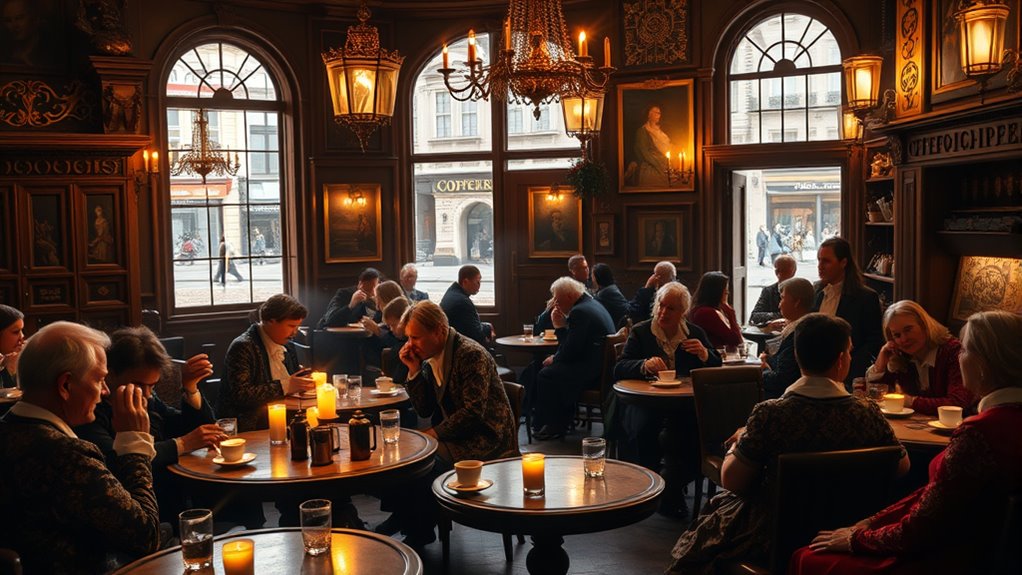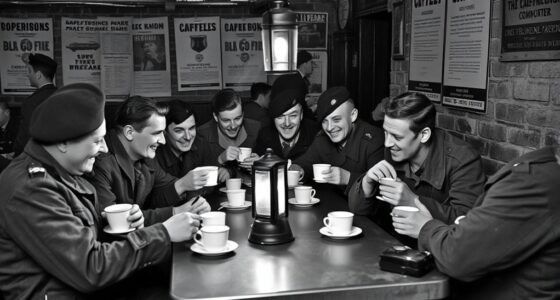Coffee first reached Europe through trade routes linking the Ottoman Empire and Venice, transforming from an exotic Middle Eastern drink into a popular social beverage. Venetian merchants imported green coffee beans from Middle Eastern ports like Mocha, with the first shipment arriving by 1615. Coffeehouses soon opened across European capitals, becoming lively hubs for debate and culture. To discover how this ancient drink shaped European society and technology, keep exploring the fascinating history behind coffee’s spread.
Key Takeaways
- Coffee was introduced to Europe via trade routes connecting the Ottoman Empire and Venice in the early 17th century.
- Venetian merchants received green coffee beans from Middle Eastern ports like Mocha, facilitating initial European contact.
- The first European shipment of coffee arrived in Venice by 1615, marking its official entry into European markets.
- Coffeehouses emerged as social hubs across Europe, rapidly spreading from Venice to other major cities.
- Technological advances, such as espresso machines and improved shipping, supported the widespread commercialization of coffee in Europe.
The Origins of Coffee in Ethiopia and the Arab World

Coffee’s journey begins in Ethiopia, where a shepherd named Kaldi noticed his goats becoming energetic after eating red berries from wild coffee bushes in the 9th century. From Ethiopia, coffee cultivation spread to Yemen, where Sufi groups used it as a stimulant during religious rituals in the late 1400s. Yemen’s port city of Mocha became a key hub for coffee trade, controlling exports and establishing a monopoly over global distribution in the 15th and 16th centuries. Arab traders played a vital role by roasting, grinding, and brewing coffee in their distinctive style—boiling coarsely ground beans with sugar and serving small cups. They kept coffee cultivation secret for centuries, mainly consuming it within the Middle East to maintain trade dominance and prevent germination of the beans. Tuning techniques, while primarily associated with automobiles, share a similar focus on optimizing performance and efficiency.
Early Trade Routes and the Rise of Yemeni Influence

Yemeni traders and Sufi religious groups played a crucial role in establishing Yemen as the center of early coffee trade. Their influence turned Mocha into a key hub for coffee exports, controlling trade routes in the Arab world during the 15th and 16th centuries. This dominance allowed Yemen to:
- Monopolize coffee exports from the Arab world, especially through port cities like Mocha and Aden.
- Spread coffee consumption and brewing techniques across the Middle East.
- Maintain control over seed distribution and trade routes, strengthening Yemen’s influence on global coffee markets.
- The emphasis on iterative processes in trade strategies helped Yemen adapt and sustain its trade dominance over time.
Thanks to these trade routes, Yemeni merchants facilitated the spread of coffee into Europe, making Yemen a pivotal player in the early history of coffee’s global journey.
The Journey of Coffee to European Port Cities

Trade routes connecting the Ottoman Empire and Venice played a crucial role in bringing coffee to Europe. Venetian merchants received green coffee beans from the Middle East, especially from the port city of Mocha, which became a key hub for coffee trade. These trade routes facilitated the movement of coffee from its origins in Yemen through Middle Eastern ports and into Italian port cities like Venice. By 1615, Venice had imported its first shipments of coffee, marking the beginning of European exposure to this exotic beverage. The port city’s strategic location allowed it to become a gateway for coffee’s arrival. From Venice, coffee spread to other European cities, laying the foundation for coffeehouses and consumption across the continent. This journey highlights the importance of trade routes in shaping Europe’s coffee history.
The Role of Merchant Ships and Colonial Expansion

Merchant ships were the essential arteries that transported coffee beans from distant regions like the Middle East, Asia, and Africa to European ports, making coffee accessible across the continent. These ships enabled:
- The establishment of trade routes connecting key ports like Venice, Amsterdam, and Marseille.
- The spread of coffee cultivation through smuggling coffee plants aboard merchant vessels, bypassing colonial restrictions.
- The growth of colonial expansion, with powers like the Dutch, French, and Portuguese establishing plantations overseas to meet Europe’s demand.
- The development of IRA investment strategies to optimize financial planning for colonial enterprises involved in the coffee trade.
Through these maritime networks, coffee moved efficiently from its origins to European markets, transforming it from a luxury item into a global commodity. Merchant ships and colonial enterprises worked hand-in-hand, fueling Europe’s coffee revolution.
First European Encounters With Coffee and Initial Impressions

When Europeans first encountered coffee, many were curious but unsure what to make of it. Some viewed it as an exotic curiosity, while others questioned its stimulating effects. These initial reactions shaped how coffee was received and gradually gained popularity across the continent.
Early European Discoveries
How did coffee make its way to Europe, and what were Europeans’ first impressions of this mysterious beverage? The journey began through Middle Eastern trade routes, where Venice received Europe’s first shipment of green coffee beans in 1615. This marked the initial European contact with coffee. The arrival of coffee was significant, but it took time to catch on. Notable milestones include:
- The opening of Venice’s first coffee house, Caffé Florian, in 1683, symbolizing coffee’s arrival.
- British explorers bringing coffee samples back to England, with Oxford’s first coffeehouse opening in 1650.
- France’s exposure to coffee around 1669, thanks to an Ottoman ambassador introducing it to Parisian high society.
These discoveries sparked curiosity, laying the groundwork for coffee’s growing popularity across Europe.
Initial Reactions and Perceptions
As coffee began to make its way into European society, reactions varied widely, reflecting both curiosity and suspicion. Initial reactions ranged from excitement about its exotic qualities to moral concern over its invigorating effects. Some perceived coffee as a mysterious, foreign beverage that challenged traditional customs, sparking suspicion. Others saw it as a potential stimulant that could boost productivity. The earliest perceptions were mixed; priests accused coffee of being the Devil’s drink, fearing moral decay. However, Pope Clement VIII’s endorsement around 1600 helped shift perceptions, baptizing coffee as a Christian beverage and easing European acceptance. The opening of the first European coffee house, Caffé Florian in Venice, marked a turning point, signaling growing social acceptance and recognition of coffee’s place in European life.
The Establishment of Coffeehouses Across European Capitals

As coffeehouses open across European capitals, they quickly become vibrant cultural hubs where ideas are exchanged and society evolves. These establishments serve as social and political centers, shaping public opinion and influencing decision-making. You’ll see how each city’s unique history and customs give rise to distinctive coffeehouse cultures that leave lasting impacts. The introduction of coffee also influenced social behaviors, encouraging more informal and open discussions in public spaces.
Cultural Hubs Emerge
The establishment of coffeehouses across European capitals transformed them into vibrant cultural hubs where people gathered to socialize, exchange ideas, and engage in lively debates. These coffeehouses became essential social hubs in Europe, fostering a lively atmosphere for cultural exchange and intellectual growth. Here’s what made them stand out:
- They attracted diverse crowds, from artists to politicians, fueling creative and political conversations.
- They became venues for the dissemination of new ideas, influencing societal shifts.
- They played a key role in shaping public opinion and fostering a sense of community.
- The integration of authentic decor and warm lighting contributed to their welcoming and engaging ambiance.
In cities like Venice, London, Paris, and Vienna, coffeehouses laid the groundwork for modern social and cultural life. Their influence extended beyond simple gatherings, shaping Europe’s intellectual landscape.
Social and Political Centers
European capitals saw coffeehouses emerge as pivotal social and political centers, transforming public spaces into arenas for debate and influence. In London, coffeehouses appeared as lively social centers where people from all backgrounds gathered to discuss politics, business, and news. These venues, known as “penny universities,” became hotbeds for political debate and intellectual exchange. Across Vienna, Paris, and Amsterdam, coffeehouses served as cultural hubs, fostering ideas that shaped history. They hosted influential movements, including the American Revolution, and helped develop financial institutions like Lloyd’s of London. By becoming spaces for vibrant discussion, coffeehouses changed the role of public gathering spots, making them essential to the political and social fabric of European life. Cultural hubs also played a role in facilitating the dissemination of new ideas and innovations, further amplifying their importance in European society.
Cultural and Social Impact of Coffee in Early Europe

Coffeehouses quickly became vibrant centers of social life, where people gathered not just to enjoy a stimulating beverage but to exchange ideas, debate politics, and discuss literature. These coffeehouses served as key social spaces, shaping the cultural significance of coffee in early Europe. They promoted cross-class interaction, allowing bourgeois citizens and workers to connect outside aristocratic circles. As a result, they helped establish the public sphere, fostering open discourse. Key impacts include:
- The rise of “penny universities” for lively debates on politics and arts.
- The emergence of coffeehouses as hubs for cultural expression, inspiring works like Bach’s Coffee Cantata.
- Their role in revolutionary movements, such as the public reading of the Declaration of Independence. These social spaces transformed European society, blending entertainment, education, and civic engagement. Additionally, the diversification of social venues contributed to the evolving landscape of public discourse and societal change.
Technological Innovations and the Commercialization of Coffee

Technological innovations have profoundly transformed coffee preparation and consumption, making it more efficient and accessible. The invention of espresso machines in 1822 by Louis Bernard Rabaut revolutionized brewing by forcing hot water through coffee grounds with steam, delivering quick, consistent shots. Early European advancements in roasting techniques and grinding tools, like portable hand grinders, improved coffee quality and efficiency. The rise of commercial coffee roasting companies, such as Roast & Post Coffee, popularized freshly roasted beans and introduced packaged coffee, boosting sales. Modern brewing equipment, including drip brewers, French presses, and capsule machines, now offer diverse styles to a broad audience worldwide. Additionally, global trade routes and shipping technology facilitated the mass importation of coffee beans, fueling its widespread commercialization and consumption across Europe. As AI technology continues to evolve, it is increasingly being integrated into retail and supply chain management, further enhancing the efficiency of coffee distribution networks.
Frequently Asked Questions
How Did Coffee Spread to Europe?
You see, coffee spread to Europe mainly through trade routes connecting the Middle East and Venice around 1615. Traders brought it from Constantinople, and it quickly gained popularity among merchants and intellectuals. Priests initially condemned it, but with Pope Clement VIII’s blessing, it became widely accepted. French and English traders soon introduced it to their countries, and coffeehouses became centers of social and intellectual life across Europe.
Why Was Coffee so Controversial When It Came to Europe?
You see, coffee’s controversy in Europe sparks like a fiery debate around a bubbling cauldron. Its dark, mysterious origins linked it to Muslim and Ottoman cultures, stirring suspicion and moral panic. Religious authorities feared it was the Devil’s drink, while governments worried about revolutionary ideas brewing in coffeehouses. Despite this, influential figures like the Pope helped tame the storm, paving the way for coffee’s acceptance and transformation into a European staple.
Who Introduced Coffee to Europe in 1615?
You’re curious about who brought coffee to Europe in 1615. It was Venetian traders who played a pivotal role, importing green coffee beans from the Middle East. These traders, involved in Eastern trade routes, introduced coffee as a luxury item, marking the start of European awareness. Their efforts helped establish coffee’s presence in Venice, paving the way for widespread adoption across the continent.
Did the Dutch Bring Coffee to Europe?
You might think coffee just appeared in Europe overnight, but the Dutch were the true pioneers. They secretly smuggled coffee seedlings from Yemen and Arab regions, then cultivated them in their colonies like Java. Through their daring efforts, they exported beans and plants across the oceans, planting the seeds for Europe’s coffee obsession. So yes, the Dutch didn’t just bring coffee—they ignited the European coffee revolution itself.
Conclusion
As you explore coffee’s journey from distant lands to your cup, you’ll see how it gently wove itself into European life, transforming social spaces and daily routines. Its voyage hints at a world connected by curiosity and trade, inviting you to appreciate the blend of history and culture in every sip. So, next time you enjoy coffee, remember the fascinating story of discovery and exchange that brought this beloved beverage to your hands.









